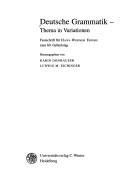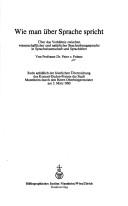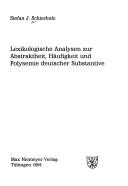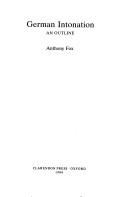| Listing 1 - 10 of 1921 | << page >> |
Sort by
|
Book
ISBN: 9783374044085 9783438062758 Year: 2016 Publisher: Leipzig Evangelische Verlagsanstalt
Abstract | Keywords | Export | Availability | Bookmark
 Loading...
Loading...Choose an application
- Reference Manager
- EndNote
- RefWorks (Direct export to RefWorks)
Bibelübersetzung --- Deutsche Sprache --- Hochdeutsch --- Luther --- Lutherbibel --- Reformation --- Reformationsjubiläum

ISBN: 3825307956 Year: 1998 Publisher: Heidelberg Winter
Abstract | Keywords | Export | Availability | Bookmark
 Loading...
Loading...Choose an application
- Reference Manager
- EndNote
- RefWorks (Direct export to RefWorks)
Grammar --- German language --- Grammar. --- Ashkenazic German language --- Hochdeutsch --- Judaeo-German language (German) --- Judendeutsch language --- Judeo-German language (German) --- Jüdisch-Deutsch language --- Jüdischdeutsch language --- Germanic languages

ISBN: 3411010207 9783411010202 Year: 1980 Volume: 45 Publisher: Mannheim Bibliographisches Institut
Abstract | Keywords | Export | Availability | Bookmark
 Loading...
Loading...Choose an application
- Reference Manager
- EndNote
- RefWorks (Direct export to RefWorks)

ISBN: 3484302690 1306292921 3111702529 Year: 1991 Volume: vol 269 Publisher: Tübingen Niemeyer
Abstract | Keywords | Export | Availability | Bookmark
 Loading...
Loading...Choose an application
- Reference Manager
- EndNote
- RefWorks (Direct export to RefWorks)
Lexikologische Analysen Zur Abstraktheit, H Ufigkeit Und Polysemie Deutscher Substantive (Linguistische Arbeiten)
German language --- Noun --- Vocabulary --- Ashkenazic German language --- Hochdeutsch --- Judaeo-German language (German) --- Judendeutsch language --- Judeo-German language (German) --- Jüdisch-Deutsch language --- Jüdischdeutsch language --- Germanic languages
Book
ISBN: 3484303360 3111847837 3110966069 9783110966060 9783484303362 3484303370 Year: 2012 Volume: 336 Publisher: Tübingen
Abstract | Keywords | Export | Availability | Bookmark
 Loading...
Loading...Choose an application
- Reference Manager
- EndNote
- RefWorks (Direct export to RefWorks)
This book deals with the phonological event of final devoicing in a theoretical framework based on principles and parameters rather than rules. It refers to data coming almost exclusively from German (native and non-native items). The first chapter presents the 'raw facts', providing an outline of the sort of alternations and distributional restrictions on voicing to be accounted for. Previous treatments of final devoicing in German are discussed and evaluated in the second chapter. Chapters 3 and 4 provide an analysis of final devoicing in German couched in the framework of Government Phonology (GP), a phonological theory operating with principles and parameters. Some of the central tenets of GP are introduced at the beginning of chapter 3, and additional concepts of the theory are explained as they become relevant to the discussion of final devoicing. The author argues that final devoicing should be interpreted as a phonological weakening process involving the withdrawal of autosegmental licensing from the laryngeal element L (which represents voicing in obstruents). This occurs in phonologically 'weak' environments, where, due to clearly definable prosodic conditions, only reduced autosegmental licensing potential is available. This analysis, developed with reference to the prestige variety of German (Hochlautung), is then extended to Northern Standard German, and the phonological differences between the two dialects are identified. In the final chapter, the author investigates whether final devoicing results in phonological neutralisation, as is often assumed in the literature. She observes that the GP account developed in chapters 3 and 4 is incompatible with this traditional view. This is desirable, since, among other things, the conflict between earlier phonological analyses and experimental studies of final devoicing can now be resolved.
German language --- Phonology. --- Consonants. --- Ashkenazic German language --- Hochdeutsch --- Judaeo-German language (German) --- Judendeutsch language --- Judeo-German language (German) --- Jüdisch-Deutsch language --- Jüdischdeutsch language --- Germanic languages --- Phonology
Periodical
Abstract | Keywords | Export | Availability | Bookmark
 Loading...
Loading...Choose an application
- Reference Manager
- EndNote
- RefWorks (Direct export to RefWorks)
German language --- Ashkenazic German language --- Hochdeutsch --- Judaeo-German language (German) --- Judendeutsch language --- Judeo-German language (German) --- Jüdisch-Deutsch language --- Jüdischdeutsch language --- Germanic languages --- Dialects --- Dialects.
Book
ISBN: 3720150569 9783720150569 Year: 1975 Volume: 56 Publisher: Zürich Interfrom AG
Abstract | Keywords | Export | Availability | Bookmark
 Loading...
Loading...Choose an application
- Reference Manager
- EndNote
- RefWorks (Direct export to RefWorks)
Book
ISBN: 3451166690 9783451166693 Year: 1973 Publisher: Freiburg Herder
Abstract | Keywords | Export | Availability | Bookmark
 Loading...
Loading...Choose an application
- Reference Manager
- EndNote
- RefWorks (Direct export to RefWorks)
Book
ISBN: 9783468490378 9783468490415 3468490372 Year: 2008 Publisher: Berlin : Langenscheidt,
Abstract | Keywords | Export | Availability | Bookmark
 Loading...
Loading...Choose an application
- Reference Manager
- EndNote
- RefWorks (Direct export to RefWorks)
German language --- -433 --- Aa3 --- Ashkenazic German language --- Hochdeutsch --- Judaeo-German language (German) --- Judendeutsch language --- Judeo-German language (German) --- Jüdisch-Deutsch language --- Jüdischdeutsch language --- Germanic languages

ISBN: 0198157940 Year: 1984 Publisher: Oxford Clarendon
Abstract | Keywords | Export | Availability | Bookmark
 Loading...
Loading...Choose an application
- Reference Manager
- EndNote
- RefWorks (Direct export to RefWorks)
German language --- -Ashkenazic German language --- Hochdeutsch --- Judaeo-German language (German) --- Judendeutsch language --- Judeo-German language (German) --- Jüdisch-Deutsch language --- Jüdischdeutsch language --- Germanic languages --- Intonation --- -Intonation
| Listing 1 - 10 of 1921 | << page >> |
Sort by
|

 Search
Search Feedback
Feedback About UniCat
About UniCat  Help
Help News
News